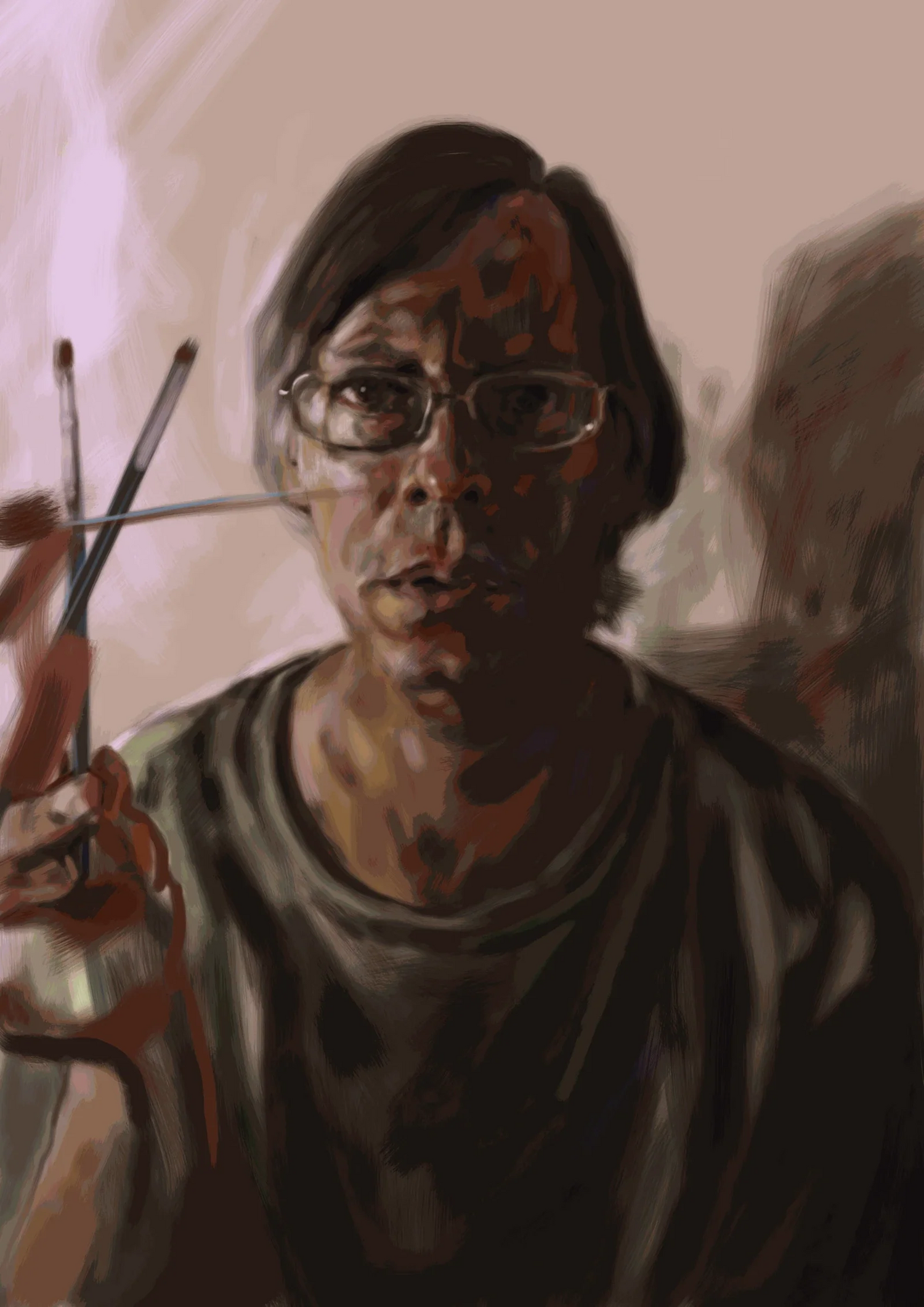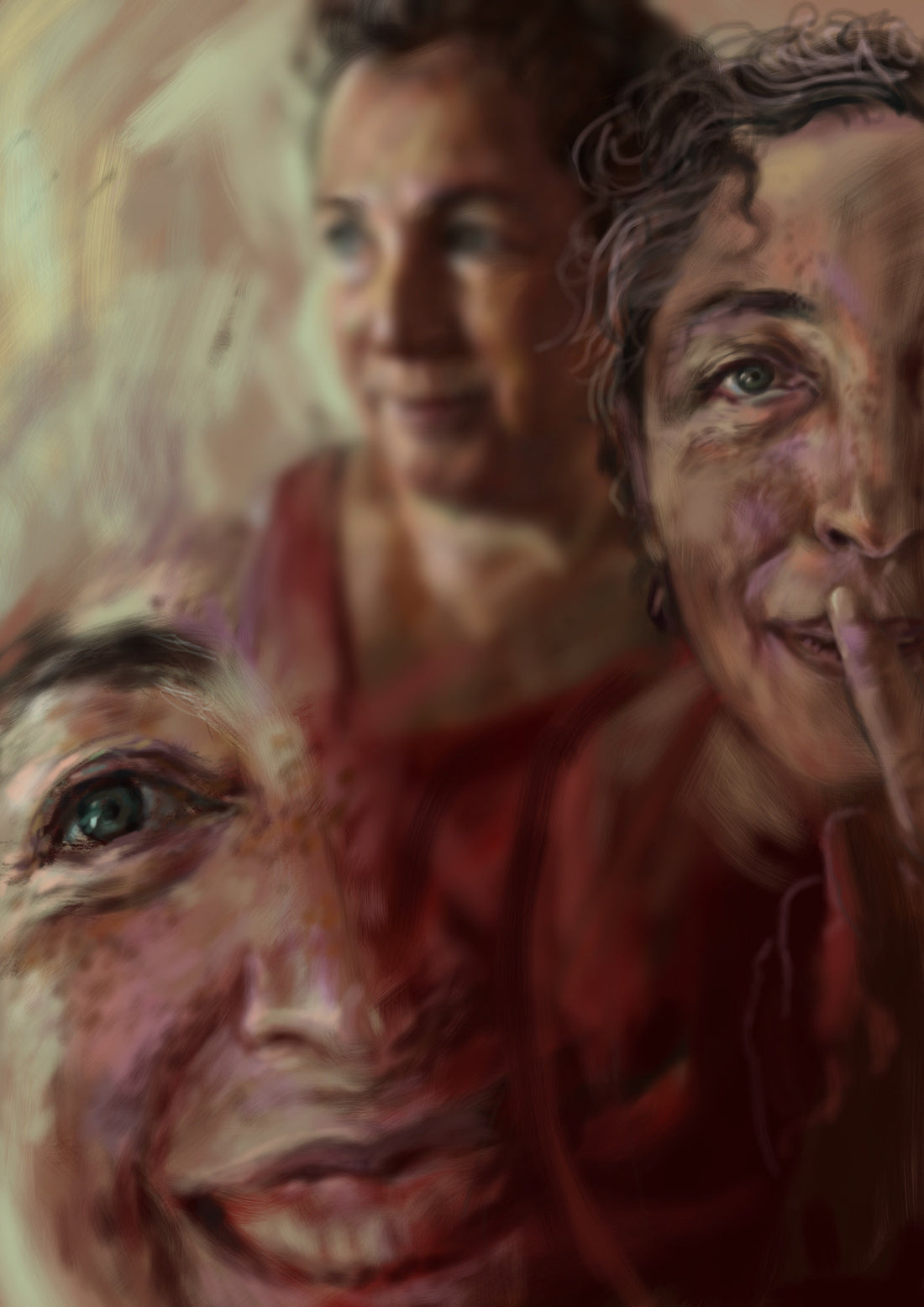Adam James Butcher
1 - 31 August 2016

GAZELL.iO is pleased to welcome Adam James Butcher as our artist-in-residence for August.
I’ve started working on a new series for the GAZELL.iO digital residency. I’m using the Procreate application with a slightly modified brush setting. I am painting from observation and directly from slo-mo iPhone recordings of the sitter, which I find fascinating. This painting is of Eduardo Stein, a great local oil painter, friend and mentor. Painting from a video of a moving subject is closer to real-life experience and has pushed me to be more inventive. The video acts as an aide-memoire of the experience.

The Reasons Behind My Controversial Move From Sculptor To iPad Painter
My article was originally published by the Huffington Post on 23.11.15.
What originally inspired my returned to painting?
You might question how a portrait sculptor who trained in fine art sculpture and used traditional techniques such as carving, modelling and casting, ended up using new technologies such as his iPad as a tool too carve out a new direction in the development of his artwork.
Well it’s not that much of a surprise really. From a young age I grew up watching my grandfather painting in vibrant oil colour ‘en plein air’. It was an incredibly important time for me and I learned so much from those moments, paying attention to the way he captured what he saw around him.
I always drew and painted from a very young age. By the time I finished my A levels and went to art school, I had developed a very solid and proficient technique. Tutors found my work suited to graphic design or illustration. I wanted to follow in my grandfather’s footsteps and I opposed their views and insisted that I needed the freedom that a fine artist would be able to demand.
Nevertheless, I was stuck in my comfort zone, relishing the response I achieved from admirers of my work. I was lucky to have a very wise tutor who helped me break out of this rut. She made a few suggestions and from then on I worked solely in three dimensions for many years. The constraints and practicalities of creating sculpture, forced me to work more rigorously and look harder at my subject and therefore I produced more innovative work.
How the iPad became a key factor in helping me rebuilding my confidence using colour?
Years later, I found that I had lost the confidence of using colour. During the 17 valuable years I spent as a head of art in an innovative Art Specialist Academy in London, I specialised in the use of new technologies such as tablets, as creative tools for developing and making art. It was only recently, since moving to Mexico to concentrate full time on my own practise, that I returned to painting as my main medium. The iPad became the natural tool in supporting this transition.
It took me sixth months of practise to start mastering new painting applications such as Procreate and Inspire Pro, mainly using my fingers or a stylus to make marks. The ability to undo unwanted strokes, gave me the confidence I needed and allowed me to experiment freely like a child again. I would in a very short time feel confident recording from observation using bold colour. And once I started using colour I was addicted.
Why the iPad allowed me to continue working even during a stressful relocation to Mexico?
Again, during our relocation to The Mexican Riviera, the iPad came into its own. I needed to invest in very little equipment to continue making art. My whole studio was effectively in my iPad and this enabled me to be so much more mobile. Almost a year later and settled in our new home, I have a studio and I have specialised in digital portrait painting.
The reason I’m so excited about my future as a professional digital painter?
I am so excited by the response I have been receiving from people recently. In particular the success of my portrait commissions have meant that I am now regularly receiving jobs from new collectors. And new technology in the form of video calling is now enabling me to paint people from anywhere in the world directly from my studio in Mexico.
I’m still amazed by the endless possibilities the iPad can bring to my artist career.
Do you have a special event coming up that you want to celebrate in style or a special someone you would like to capture, remember, thank, surprise or honour?
CONTACT me today and we can discuss the different options available to create a portrait that is completely unique.
Hit SUBSCRIBE and be the first to receive my latest offers and news in your inbox!

The True Heart Of The Mobile Digital Art Movement
My article was first published by The Huffington Post on 03.08.16.
The first digital machines were somewhat clumsy as fine art tools. The transformations have been astonishing since the first enormous and very stationary computing machines.
Today the developments are much harder to pin down. There are so many new technologies that have the potential to be used as creative vehicles. It’s a time where social habits define the way we make, share, discover, experience, and buy art.
This fascinates me, and I want to talk about the relevance of the mobile digital art phenomenon that has grown into a global trend.
Mobile devices have become digital visual journals that act like the artist’s whole studio and gallery on the move. The iPad in particular has found its place at the very heart of my practice.
It’s only recently that applications have become responsive and complex enough to be used seriously by professional fine artists. Ironically, I don’t think Apple intended or envisaged that it would play such an essential part in the artistic process.
Let’s not forget why Steve Jobs invented it for in the first place.
“iPad creates and defines an entire new category of devices that will connect users with their apps and content in a much more intimate, intuitive, and fun way than ever before.”
If we look at Steve Jobs’ insightful language on launching the first iPad, the words connect, intimate, intuitive and fun stand out. Today, these words represent the key aspects of what makes this movement unique.
The mobile digital art movement, by title alone, suggests the celebration of exponential change.
“Defining ‘mobile digital art’ is like trying to define a moving target. Moving in space, since we’re talking about mobility – art on the move – and moving in time, since everything’s heading mobile!”
Jeremy Sutton
However questionable they were, it was the many manifestos written by the avant guard artists of the early twentieth century that were useful in changing the core underlying values of artistic beliefs and conventions. These notes were key in expressing new ideas, and I think they are worthy of attention and study. They marked those important moments in the evolution of an individual’s creative ideas. They acted as the blog posts of the past.
This versatile mobile digital art medium has officially hit the art world with a Big Bang. Tablets, iPhones and iPads have come into their own as serious tools for a growing number of professional fine artists. It’s not surprising then that artists have been quick to take advantage of the portability, speed, and accessibility of this medium.
Mobiles and iPads have been around for a while, so why have the last few years been significant? A number of professional fine artists, including myself, have been using this medium for a while, either on its own or as a tool alongside more traditional materials and techniques.
Nevertheless, it’s only just recently that the movement has started to grow into a recognized and validated community, not with a closed-minded outlook but with an open attitude to change and the sharing of new ideas. To me, that’s what truly validates a movement, not critics or historians.
We live in an exciting time where the are no boundaries in global communication. I think that this holds the key to the current popularity of digital art made with the aid of mobile devices such as the iPhone and iPad.
Why is this movement so significant now?
The solitary artist confined to his studio is a rarity now, and the mobile art movement is a reflection of this.The community side of the movement is particularly useful and exciting, as it not only engages art aficionados on a global level, but helps build a collector base for artists who have mastered this multifaceted medium.
With these points in mind, it was no coincidence that I was recently contacted by The Mobile Art Academy, one of the central official online hubs hosting the Mobile Art movement. They discovered my work through social media and asked me to give a speech about how I use the iPad in my creative process at their mDAC summit in Palo Alto later in August 2016. Silicone Valley is also the nerve center of applications such as Autodesk, which has been loyal sponsor of this vibrant platform since it began (along with Procreate and ArtRage).
In my mind, the beauty of this kind of organization is it’s support of independent professionals. It enables artists such as myself to connect with their audiences and their contemporaries, and aspiring amateur artists have direct access to professionals who use the medium to its highest levels.
I think that the mobile art movement will represent a key turning point in history when art became accessible to all. For those who are part of the mobile art movement today, let’s be proud to be its pioneers.The mobile digital art movement should celebrate change and innovation.
Let’s celebrate our ability to embrace the ephemeral nature of creative tools like the iPad as challenging new vehicles in the ongoing creative process.
Visit www.adamjamesbutcher.com/blog to view updates on the mDAC event and to learn more about how I help artists use the iPAD to take their art practice to the next level.
Follow Adam James Butcher J on Instagram: www.instagram.com/adambutcher19









